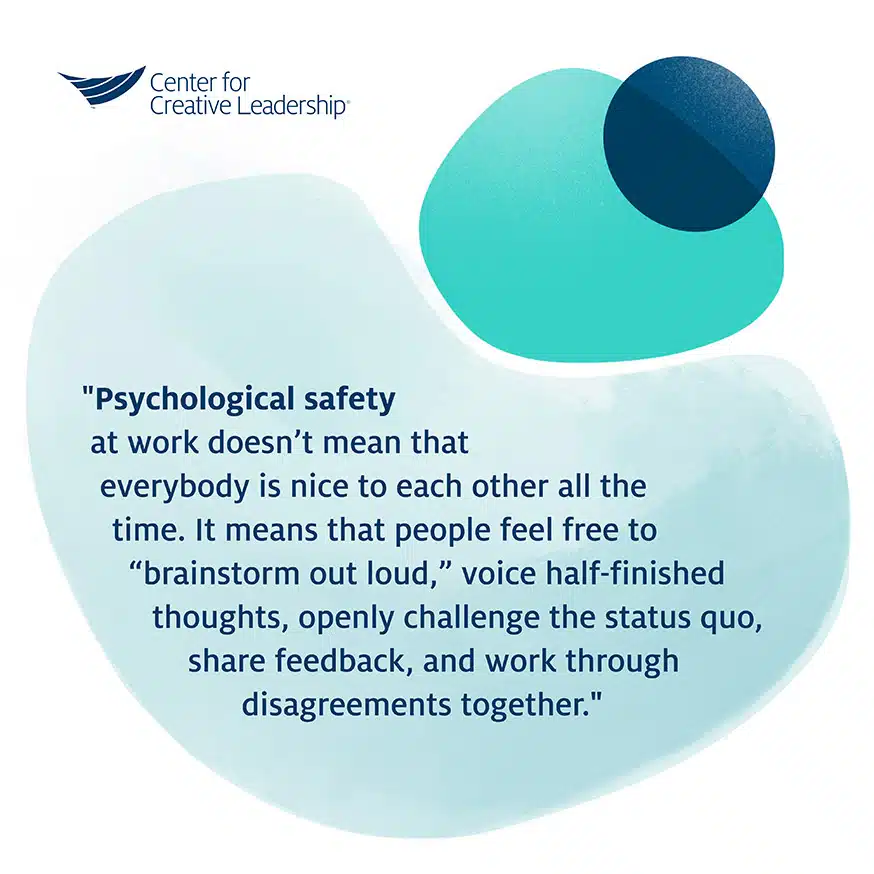What Is Psychological Safety at Work?
Psychological safety is the belief that you won’t be punished or humiliated for speaking up with ideas, questions, concerns, or mistakes. Psychological safety at work is a shared expectation held by members of a team that teammates will not embarrass, reject, or punish them for sharing ideas, taking risks, or soliciting feedback.
Psychological safety in the workplace doesn’t mean that everybody is nice to each other all the time. Rather, it means that people feel free to “brainstorm out loud,” voice half-finished thoughts, openly challenge the status quo, share feedback, and work through disagreements together — knowing that leaders value honesty, candor, and truth-telling, and that team members will have one another’s backs.
When workplace psychological safety is present, people feel comfortable bringing their full, authentic selves to work and are okay with “laying themselves on the line” in front of others. And organizations with psychologically safe work environments — where employees feel free to ask bold questions, share concerns, ask for help, and take calculated risks — are all the better for it.
In fact, in a research study we conducted of nearly 300 leaders over 2.5 years, we found that teams with high degrees of psychological safety reported higher levels of performance and lower levels of interpersonal conflict.
It’s important to note that not all team members hold the same perceptions, though. The stakes are particularly high for senior leadership teams, where our research found members reported the greatest differences in their perceived levels of psychological safety at work — 62% of senior teams in our sample demonstrated significant variability around their team’s psychological safety. This has real business repercussions; when innovative ideas go unsaid, creative problem solving is squashed, and teams fail to collaborate and innovate together to their full potential.
The Importance of Psychological Safety in the Workplace
Psychological safety at work is not just a “nice to have;” it impacts the organization’s bottom line. Having a higher level of consistent psychological safety helps to unlock the contributions of all talent in the enterprise and ensures the organization is better equipped to prevent failure.
Research has repeatedly found that organizations benefit from diversity of thought, and groups of people with different life experiences are better able to recognize problems and offer up creative solutions than groups with similar life experiences.
But what if some team members don’t feel comfortable speaking up? What if they’re afraid to share their perspective, raise concerns, or asking challenging questions? What if they avoid suggesting new and innovative ideas because they’re worried about the repercussions?
Unfortunately, many people feel this way about their workplace. According to a 2019 Gallup poll, just 3 out of 10 employees strongly agreed that their opinions count at work.
It can be especially challenging for members of social identity groups that are often marginalized by society to feel high levels of psychological safety in the workplace. For example, a recent survey from Catalyst found that nearly half of female business leaders face difficulties speaking up in virtual meetings, and 1 in 5 reported feeling overlooked or ignored during video calls. Those who are members of historically underrepresented groups may feel this reality even more keenly.
Colleagues who feel their work environment is psychologically safe are more willing to engage in interpersonal risk-taking behaviors that contribute to greater organizational innovation — like speaking up, asking questions, sharing unspoken reservations, and respectfully disagreeing. This ultimately yields a more robust, dynamic, innovative, and inclusive organizational culture.
In contrast, when psychological safety at work is low and people are uncomfortable raising concerns, initiatives that aren’t working move forward anyway, the organization isn’t equipped to prevent failure, and talent begins to disengage. When employees aren’t fully committed to shared organizational success, ideas aren’t stress-tested, processes aren’t optimized, solutions aren’t vetted, and the enterprise has lost an opportunity to leverage the contributions of all its talent.
Why Psychological Safety in the Workplace Matters Now More Than Ever
The rise of the hybrid workplace and virtual work arrangements since the pandemic have made psychological safety at work more complex for leaders today. It can be harder to build a psychologically safe “workplace” when employees are not all co-located, and many are working remotely.
After all, how do you establish trust when interpersonal conversations have to be scheduled in advance, and many are conducted through a screen? Yet leading remote teams may give leaders a unique opportunity to forge connections and increase psychological safety — if they’re paying attention.
In an on-camera virtual meeting, you can look intently at people, perhaps more so than you could in person. (In many cultures, it can be awkward to stare at someone for 30 seconds or minutes at a time.) But on videoconferences, no one knows who you’re looking at, so you can watch the speaker closely — absorbing not just their words, but also their emotions and values. Leaders can seize this opportunity to explore authentic communication in virtual settings through the power of listening.
Plus, many people feel more comfortable typing vulnerable statements through a screen (for example, into a meeting chat) than they would speaking in person. In those settings, they may appreciate a chance to spend a little more time thinking through how they want to convey information to maximize impact. Leaders can show respect for those courageous enough to share their honest thoughts — again, recognizing the vulnerability required to do so, and responding with appreciation.
8 Steps Toward Creating More Psychological Safety at Work
Our Tips for Leaders
Here’s how leaders can help create a more psychologically safe workplace.
1. Make psychological safety an explicit priority.
Talk with your team about the importance of creating psychological safety at work. Connect it to a higher purpose of greater organizational innovation, team engagement, and inclusion. Ask for help when you need it, and freely give help when asked. Model the behaviors you want to see, and set the stage by using inclusive leadership practices.
2. Facilitate everyone speaking up.
Show genuine curiosity, and honor frankness and truth-telling. Be an open-minded, compassionate leader, and willing to listen when someone is brave enough to say something challenging the status quo. Organizations with a coaching culture will more likely have team members with the courage to speak the truth.
3. Establish norms for how failure is handled.
Don’t punish experimentation and (reasonable) risk-taking. Show recognition that mistakes are an opportunity for growth. Encourage learning from failure and disappointment, and openly share your hard-won lessons learned from mistakes. This will help encourage innovation, instead of sabotaging it. Use candor when expressing disappointment (and appreciation).
4. Create space for new ideas (even wild ones).
Provide any challenge within the larger context of support. Consider whether you only want ideas that have been thoroughly tested, or whether you’re willing to accept highly creative, out-of-the-box ideas that are not yet well-formulated. It’s fine to ask the tough questions; but do so while always being supportive at the same time. Learn more about how to foster more innovative mindsets on your team.
5. Embrace productive conflict.
Promote sincere dialogue and constructive debate, and work to resolve conflicts productively. Set the stage for incremental change by establishing team expectations for factors that contribute to psychological safety. With your team, discuss the following questions:
- How will team members communicate their concerns about a process that isn’t working?
- How can reservations be shared with colleagues in a respectful manner?
- What are our norms for managing conflicting perspectives?
6. Pay close attention and look for patterns.
Focus on team members’ perceived patterns of psychological safety, not just the overall level. Do some members experience significantly more or less psychological safety than others, or is the level fairly even across the team?
- Advocate for consistent psychological safety for everyone, and not just as a “nice to have” — it matters for the bottom line.
- Consider the team’s current beliefs when developing strategies to enhance team psychological safety, because one size does not fit all.
7. Make an intentional effort to promote dialogue.
Promote skill at giving and receiving feedback, and create space for people to raise concerns. Ask colleagues powerful, open-ended questions, and then listen actively and intently to understand their feelings and values, as well as facts. Provide opportunities to learn how to share constructive feedback to one another and what respectful responses look like.
You may want to consider investments in strengthening the quality of conversations across the organization, because quite literally, better conversations will lead to a better culture. Improved skill at feedback conversations, combined with a psychologically safe work environment, will yield colleagues who are more willing to share unspoken reservations with one another and propose solutions that are more rigorously stress-tested before implementation.
8. Celebrate wins.
Notice and acknowledge what’s going well. Positive interactions and conversations between individuals are built on trust and mutual respect. So share credit and embrace expertise among many, and the success of the collective, versus a single “hero” mentality.
Celebrate what’s going well, however small, and appreciate people’s efforts. Encouraging and expressing gratitude reinforces your team members’ sense of self. Give your team members the benefit of the doubt when they take a risk, ask for help, or admit a mistake. In turn, trust that they will do the same for you.
The 4 Stages of Psychological Safety
Has Your Organization Moved Through Each Phase?
As organizations build greater psychological safety, 4 recognizable stages emerge.
A psychologically safe workplace begins with a feeling of belonging. Like Maslow’s hierarchy of basic needs, employees must feel accepted before they’re able to contribute fully in ways that improve their organizations.
According to Dr. Timothy Clark, author of The 4 Stages of Psychological Safety: Defining the Path to Inclusion and Innovation, employees have to progress through the following 4 stages before they feel free to make valuable contributions and challenge the status quo.
Stage 1 — Inclusion Safety
Inclusion safety satisfies the basic human need to connect and belong. In this stage, you feel safe to be yourself and are accepted for who you are, including your unique attributes and defining characteristics.
Stage 2 — Learner Safety
Learner safety satisfies the need to learn and grow. In this stage, you feel safe to exchange in the learning process by asking questions, giving and receiving feedback, experimenting, and making mistakes.
Stage 3 — Contributor Safety
Contributor safety satisfies the need to make a difference. You feel safe to use your skills and abilities to make a meaningful contribution.
Stage 4 — Challenger Safety
Challenger safety satisfies the need to make things better. You feel safe to speak up and challenge the status quo when you think there’s an opportunity to change or improve.
To help employees move through the 4 stages and ultimately land in a place where they feel comfortable with interpersonal risk-taking and speaking up, leaders should nurture and promote their team’s sense of psychological safety in the workplace.
When a team or organizational climate is characterized by interpersonal trust, respect, and a sense of belonging at work, members feel free to collaborate and they feel safe taking risks, which ultimately enables them to drive innovation more effectively.
Create Psychological Safety in the Workplace at Your Organization
Today’s leaders need the ability to address complex challenges in new and innovative ways. Strengthen your organizational culture and help your teams establish a climate of trust and psychological safety at work using our research-based topic modules.
Available leadership topics include Collaboration & Teamwork, Communication, Emotional Intelligence & Empathy, Listening to Understand, Psychological Safety & Trust, and more.
Psychological Safety Reveals Your Work Culture
The levels of psychological safety in your workplace represent your organization’s climate and culture. A culture is simplistically defined by “the way we do things around here,” and everyone has a role to play in how work gets done. Leaders are especially key in shaping organizational culture — both on our teams and in our organizations.
Changing a culture is never fast or easy, but transforming your organization to build psychological safety for everyone is definitely worthwhile.
If it feels like a tall order, remember that transformation comes in the form of small steps, so think about changing your culture in terms of making incremental changes that yield incremental wins. Ask colleagues if they’re willing to sign up for improving 1% each day. By the end of a year, your organization will be exponentially stronger.
Remember, the goal is to create psychological safety at work where team members aren’t worried about feeling rejected for speaking up. When that’s the case, not only does interpersonal risk-taking become the norm, but teams are also more adaptable in the face of change.
In other words, they understand the challenges and opportunities that exist throughout the organization — and they see their role in making it a better place.
Ready to Take the Next Step?
Start building a psychologically safe workplace today: Take our Psychological Safety Challenge to discover 7 specific practices to try in your conversations next week.
Start building more psychological safety at work and at home with our week-long challenge.












